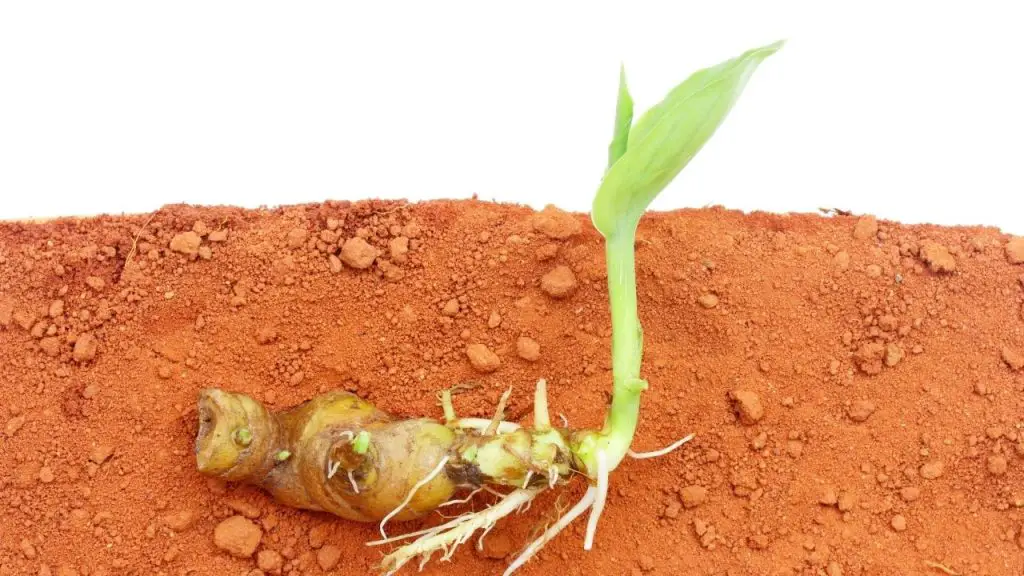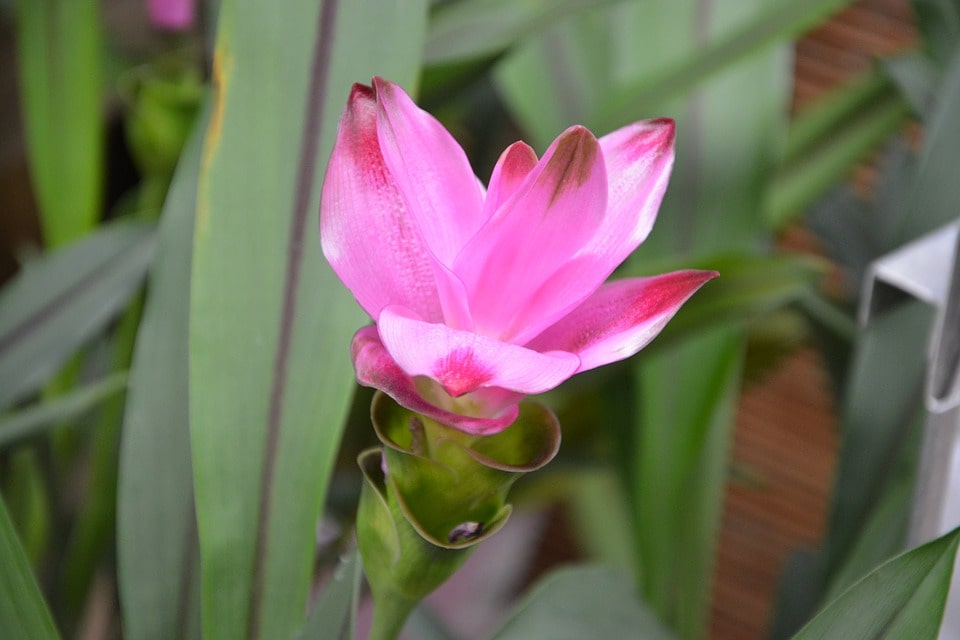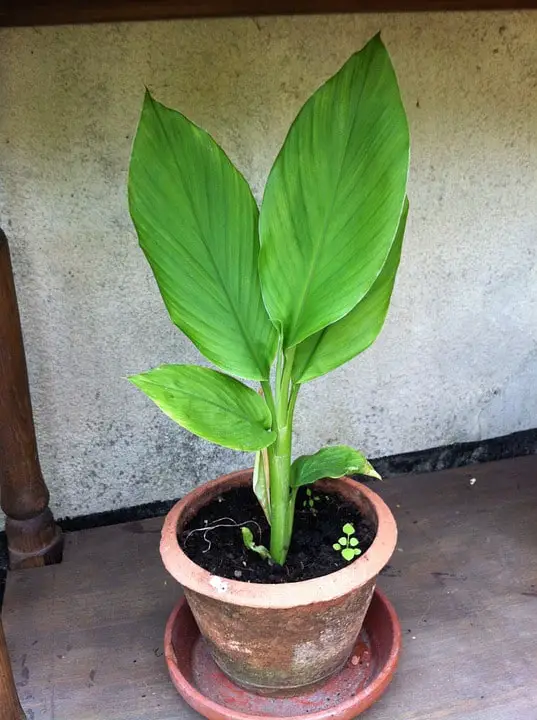Turmeric, botanically known as Curcuma longa, is from the species of ginger, it is valued for its unique taste, color, and therapeutic and medicinal roots properties.
Turmeric is one of those intriguing and exotic plants that so many farmers covet. While growing turmeric keep a watch if you see slow growth,many times it lacks in calcium, & nitrogen.Most people know turmeric as a bright, healthy ground spice used in curry, but they have no idea how turmeric is grown or even what is purmeric plant looks like.
It is not difficult to grow turmeric, despite its unusual appearance. Turmeric can be grown successfully in most climes with a few adjustments. Continue reading to learn how to grow turmeric plants successfully and how to use this medicinal root in a variety of ways.
Turmeric Plant Profile
Here is a short description of the turmeric plant, to understand it better.

| Attributes | Properties |
|---|---|
| Botanical Name | Curcuma longa |
| Common Name | Turmeric, common turmeric, turmeric root |
| Plant Type | Herbaceous perennial |
| Mature Size | 3 to 4 feet tall and wide |
| Best Growing season | mid-December and mid-March. |
| Soil Type | Rich, well-drained, and consistently moist |
| Sun Exposure | Full sun in the far North, partial sun elsewhere |
| Native Area | India and Malaysia |
| Flower (Bract) Color | Burgundy, green, pink, white, yellow, or bicolored |
| Bloom Time | July to August |
| Soil pH | Slightly acidic to slightly alkaline |
| Toxicity | Non-toxic |
| USDA Plant Hardiness Zones | Zones 8 to 11 |
What Are The Benefits Of Turmeric?
The plant has been in use for spice and medicinal purposes for years. The main active component found in the plant is Curcuminoids. The top scientifically proven use of turmeric and curcumin root are listed below.

1. Gives an appetizing color
Turmeric is the yellowish spice that gives curry its color. That make food delishish looking and makes it more appetizing.
2. As an Anti-inflammatory
Persistent low-level inflammation plays a significant role in various health disorders and diseases, according to scientists. Heart disease, cancer, and metabolic syndrome, and many types of degenerative diseases are among them.
It has been shown that Curcumin has worked against inflammation and this will help in this case.
3. Treatment Of Hyperlipidemia
Cholesterol or any other fats in the blood at dangerously high levels (hyperlipidemia). Turmeric, when taken orally, appears to reduce triglyceride levels in the blood.
4. Curcumin can boost brain-derived neurotrophic factor
Before deep research was performed on neurons, it was believed that they can not develop and multiply past adolescence, but now with advanced technologies used in medical research, it has been shown that they can do so.
One major factor that aids the multiplication is the brain-derived neurotrophic factor (BDNF). Turmeric curcumin has been shown to increase levels of the brain’s BDNF hormone.
5. Treatment of Hay fever
Oral intake of turmeric has been proved to alleviate the symptoms (sneezing, congestion, and runny nose) of hay fever.
6. Treatment Of Depression
Curcumin, a molecule found in turmeric, has been shown in most studies to improve depressive feelings in persons who are already taking antidepressant drugs.
7. Treatment Of Fatty Liver
In persons suffering from nonalcoholic fatty liver disease or NAFLD, oral intake of turmeric extract decreases signs of liver disorder. It also appears to prevent the accumulation of more fat in the liver.
8. Management of cancer
- Cancer is best defined as a state of uncontrollable cell growth. Curcumin supplement has been proved to have an effect on many various forms of cancer.
- Curcumin has been explored as a cancer treatment herb and has been discovered to inhibit cancer growth and development.
- It has also aided in the death of malignant cells. Perhaps high-dose curcumin, particularly with an absorption amplifier like piperine, could help manage cancer in humans by reducing angiogenesis and metastasis.
Best Turmeric Seeds For Planting?
1. Curcuma aromatica seed
Curcuma aromatica, also known as Kasturi Manjal, is a spice with a pleasant scent. Because of its harsh taste, the Kasturi Manjal is often avoided in cooking.
Most people ask, where can I get turmeric? The powder produced from this turmeric root can be purchased from any turmeric store, and it has a color that is quite similar to that of regular Turmeric.
2. Curcumin longa seed
Curry Powder, which is frequently used in cooking, contains a variety obtained from this seed. Turmeric, which comes from the Curcumin longa type, is the principal component in most curry powders and is made by boiling the curcumin root in water and afterwards drying it to generate the powder, the turmeric water can also be used for medicinal purposes.
3. Black Turmeric seed
The Kari Manjal turmeric variant, which is a unique type with slightly dark roots, is grown from this seed. This Turmeric type is used to make several Hindu medications.
4. Mara Manjal Turmeric seed
This seed produces Mara Manjal, also known as Tree Manjal, a vine that is particularly important in the preparation of some very unique remedies. Turmeric of this kind is rapidly becoming extinct in the Western Ghats.
How To Care For Turmeric Plants?
Temperature
Temperatures between 20 and 35 degrees Celsius are optimum for growing turmeric. The plant struggles when the temperature falls below 10 degrees Celsius.
Soil
Turmeric should be planted in light, loamy soil with enough organic materials. and good drainage, otherwise, the plant will suffer from a lack of drainage.
Water
Watering demand for turmeric is the same as for ginger. Keep the soil wet from spring to fall, and don’t be afraid to water the foliage to raise the moisture levels surrounding the plant in dry weather. If you’re growing turmeric in a hotter climate, keep the plant well-watered throughout the winter to keep the soil moist.
Measurements
Combine seventy to eighty percent organic potting soil or a comparable raised bed/container soil combination with twenty to thirty percent well-balanced compost in a container. Fresh animal excrement should not be used! It’s too “hot” and nitrogen-rich.
Space between plants
In turmeric farming, for the best turmeric crop yield, a 30-cm separation is sufficient. Early canopy structural development in the plants at 20 and 30-cm spacing decreases weed biomass, resulting in more turmeric crop yield.
Companions
Planting companion plants is an important element in growing turmeric. Companion plants help other plants thrive by drawing useful insects, resisting pests, and supplying nutrients, shade, and support. Here are a few plants that make wonderful turmeric companions: Tomatoes and bean plants.
Fertilizer
Turmeric is a high feeder when it is growing. Throughout the season, it will benefit from compost. Turmeric is commonly fed with old pellet chicken manure. Dress the soil top surrounding the plant spears with a light sprinkling of alfalfa meal and a fresh one to two-inch layer of manure once or twice during the growing period.
Managing Pests and Disease
There are no severe diseases or pests that affect the turmeric plant. Red spider mites and scales, on the other hand, can be a concern. It only gets rhizome rot and leaf spot as far as illnesses go. When the plant is grown in damp soil, it develops rot. As a result, growing turmeric in well-drained soil is important.
How To Propagate Turmeric.
1. Division
Divided rhizomes are the best way to grow turmeric. Harvest and preserve the turmeric rhizomes, then cut into pieces and plant twenty-five centimetres apart when fresh sprouts and roots grow, ideally in the fall.
Harvest and preserve the turmeric rhizomes, then cut them into pieces and plant twenty-five centimetres apart when fresh sprouts and roots grow, ideally in the fall.
2. Rhizomes
Turmeric rhizomes that have sprouted also grow well. In fertile soil, plant 5-7cm deep and 25cm apart in the autumn. They thrive from frequent compost, manure, and mulch feedings.
3. Seeds
Turmeric seed is uncommon, and blooms rarely bear fruit. The seeds can be planted on a germination medium and seedlings transferred after about twenty days or when they are 4cm long, however, this approach is not particularly reliable.
how to grow turmeric plant In Pot
1. Preparation
Select a pot that is at least three hundred millimetres broad and deep, place it in a bright or partially shaded location. Fill with a high-quality potting mix.

2. Planting
Plant the root piece at a depth of 5 centimetres in 35 centimetres intervals. Water well after lightly covering with the potting mix.
3. Care
Water on a regular basis. Yates Thrive Vegie Food should be fed to the pant once a week.
Harvest
In the fall, harvest the roots by pulling them out.
- CERTIFIED USDA ORGANIC TUMERIC POWERED (CURCUMA LONGA) - 16oz (1 pound) Resealable Jar. Non-GMO.
- NEW INNOVATIVE TurmiPure Gold is a patented, water-dispersible turmeric extract with significantly...
- ✔️ TNVitamins Extra Strength Turmeric Curcumin Capsules with Black Pepper
- Six 20 count boxes of Organic Ginger & Turmeric tea bags
Last update on 2024-04-18 / Affiliate links / Images from Amazon Product Advertising API
Propagation Of Turmeric Plant At Home
1. Preparing to Plant
In most regions of the world, planting turmeric indoors in the late winter yields the finest results. Depending on your indoor and outdoor space, you can maintain it as a houseplant throughout the summer or take it outside once all danger of frost has passed and the weather has warmed up.
2. Calculate when to plant.
Turmeric needs seven to ten months to mature from seed to harvest. Count back ten months from the time you generally get your first frost to determine when you should plant.
3. Planting
Turmeric root or rhizome planting.
For every six to eight inches of rhizome, you’ll need a fourteen to eighteen-inch pot or planter, as well as adequate potting soil to fill it. However, it’s easier to start by sprouting your rhizomes in smaller pots and then transplanting them into larger pots once they’ve sprouted a few leaves and are developing well.
Steps:
1. Divide your rhizomes into pieces, ensure the pieces each possess buds.
3. Cover the rhizome parts with extra potting soil and lay them flat on the soil.
4. Fill the pots with water and place them in transparent bags (plastic).
5. Put the pots in the warmest spot possible (86 to 95 degrees is ideal). Sprouting will be quite poor at lower temperatures, and the rhizomes might even decay rather than sprout.
How To Grow Turmeric plant From The Store
Turmeric is a plant with a plethora of health advantages. Turmeric and ginger can also be produced from mature rhizomes rather than seeds. Turmeric rhizomes can be simply propagated using rhizomes purchased from turmeric grocery stores.
STEP 1
Because this magnificent herb may grow up to a meter tall, the pot should be twelve inches deep and eighteen inches wide. In each container, plant two to three rhizomes.
The pot’s width should be large enough to easily contain the rhizomes. A paper napkin should be placed in the pot base. When you irrigate the soil, this will help to keep it from drying out.
STEP 2
Fill the pot halfway with a good potting mix. Garden compost can also be used, although it is highly compact and does not allow adequate airflow.
STEP 3
You can buy turmeric rhizomes in any organic food store. They can also be found at your neighbourhood garden store. Because non-organic lysosomes are treated with compounds that impede sprouting, you should buy organic rhizomes.
Take the turmeric rhizomes and keep an eye on them. Observe the turmeric you bought and make sure the rhizomes you’re going to plant have two or three buds on them. The bud will serve as the growth location where the rhizome will start sprouting. You’ll notice the rhizomes growing points, so horizontally lie them in the soil. Bury them with a little layer of soil, but not too deeply.
STEP 4
Thoroughly water the rhizomes so that their adjustment to the new environment can be hastened. After a month, the rhizomes will begin to sprout.
How To Grow Turmeric plant And Ginger Together?
GInger serves as a good companion plant to turmeric and when planted together with turmeric, the turmeric will benefit a lot from it. Propagation of ginger goes the same way as you will propagate your turmeric.
Just follow the steps already highlighted for the growth of turmeric when you plan to grow the two plants together, you just go by it as if you are planting more than one turmeric plant at the same time.
How To Harvest Turmeric
It takes turmeric around nine months to grow, therefore it’s crucial to plant it at the proper time so that the rhizomes may be harvested while the weather is still warm. Harvesting may begin when the blossoms fade and the leaves turn yellow.
Remove the entire plant top, moisten the soil, and dig out the rhizomes. Replant or use as a spice. Alternatively, carefully dig along the edge of a clump and pull off rhizomes as needed instead of collecting the entire clump.
How To Store And Preserve Turmeric
Turmeric should be used within the next few weeks of harvesting if you want to eat it fresh. Dry rhizomes should be kept in a tight container in the fridge. If you wish to replant any of the rhizomes, keep them out in a cool, dark spot for a longer amount of time.
When storing fresh turmeric, freeze a portion of it and dehydrate the rest to make turmeric powder at home. Simply place the complete rhizomes in an airtight freezing bag and store them for 1 year before usage.
The flavour will be more fresh and vibrant if you utilize them straight away. Simply take a rhizome from the freezer and grate it as needed for meals to utilize the stored turmerics.
FAQS on how to grow turmeric plant at home
Q: How long does it take to grow a turmeric plant?
About Seven To Ten Months.
Q: Where is the best place to grow turmeric?
It Will Develop Rapidly In Full Sun Or Partial Shade
Q: Does turmeric grow underground?
Yes, It’s A Meter-Tall Annual Plant With Underground Rhizomes.
Q: Can ginger and turmeric be grown together?
Turmeric And Ginger Can Both Be Planted In The Ground.
Q: What is the Golden Turmeric Tea recipe?
Golden Milk Turmeric Tea Is A Potent Anti-Inflammatory Drink Created With Turmeric That May Help With Depressive Symptoms, Heart Health, Arthritis Symptoms, And More.
Q: where can i find turmeric?
India is a country which has largest turmetic produce, and its the best quality of turmeric due to its high curcumin content. Also outside india you can get turmeric powder sprouts from farmers market.
You may also like to explore below gardening herbs care guides.
Conclusion
As you can see, the propagation of turmeric is not really a hard thing to do once you follow the right steps. Simply collect your turmeric seed or rhizomes and follow the steps above, you are guaranteed a bountiful harvest of turmeric.
Did you foind the article interesting? Please follow GardeningLovy Pinterest and save this pin to the “how to grow turmeric plant ” board. Leave a comment below, share it, like it, rate it. We’d love to hear from you! write to Contact Us.

My name is Olivia, and I live in the United States and love having plants in my garden. Lots of plants are there on my balcony, indoor and outdoor garden also. Here I am trying to share useful gardening tips, how to grow and care for various plants, etc.




